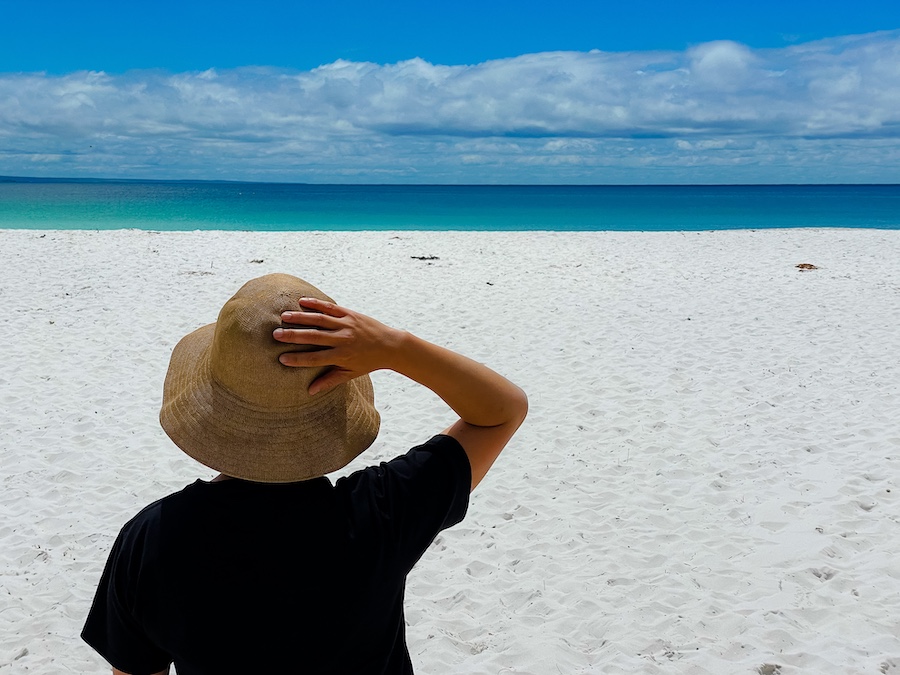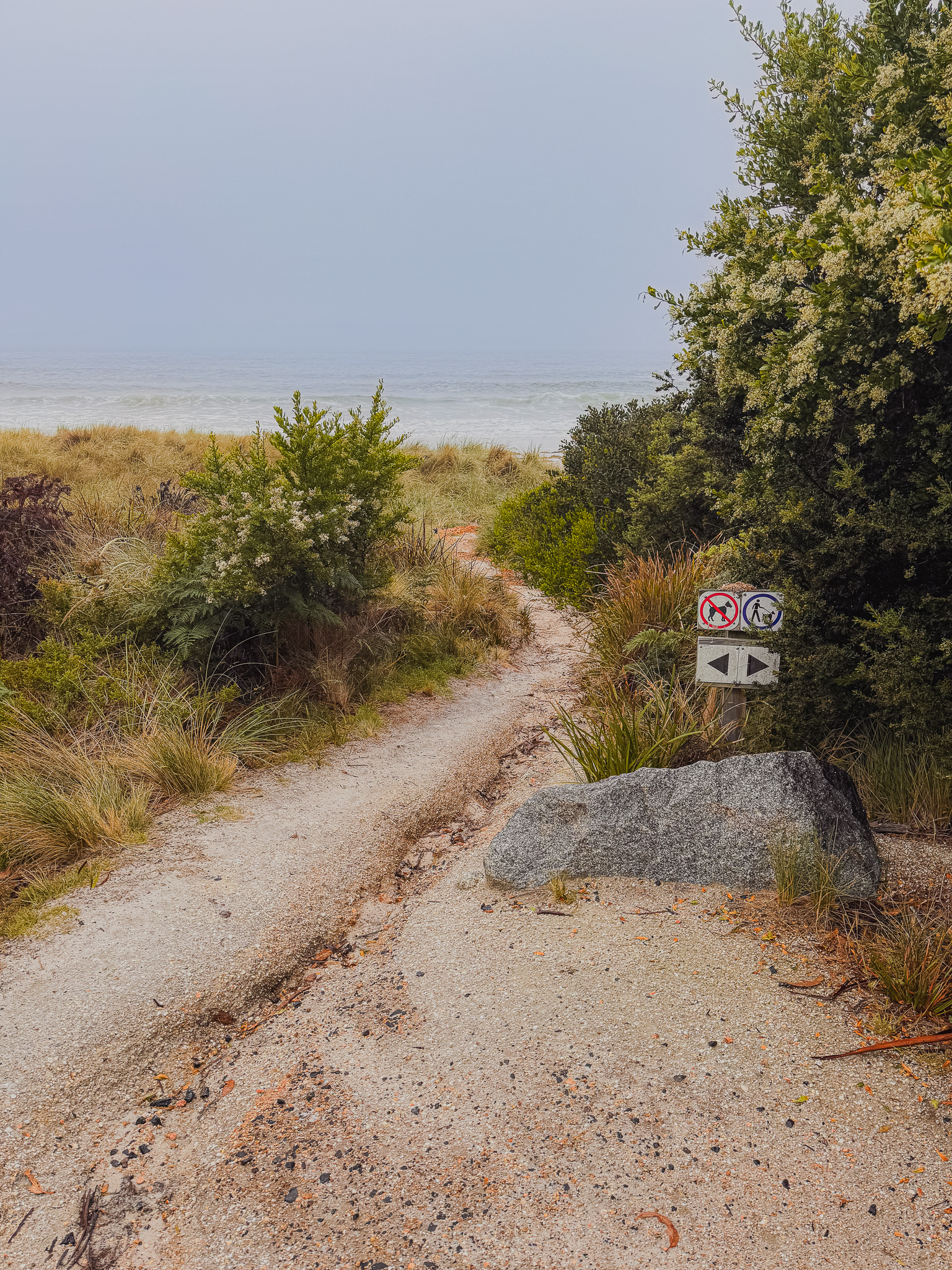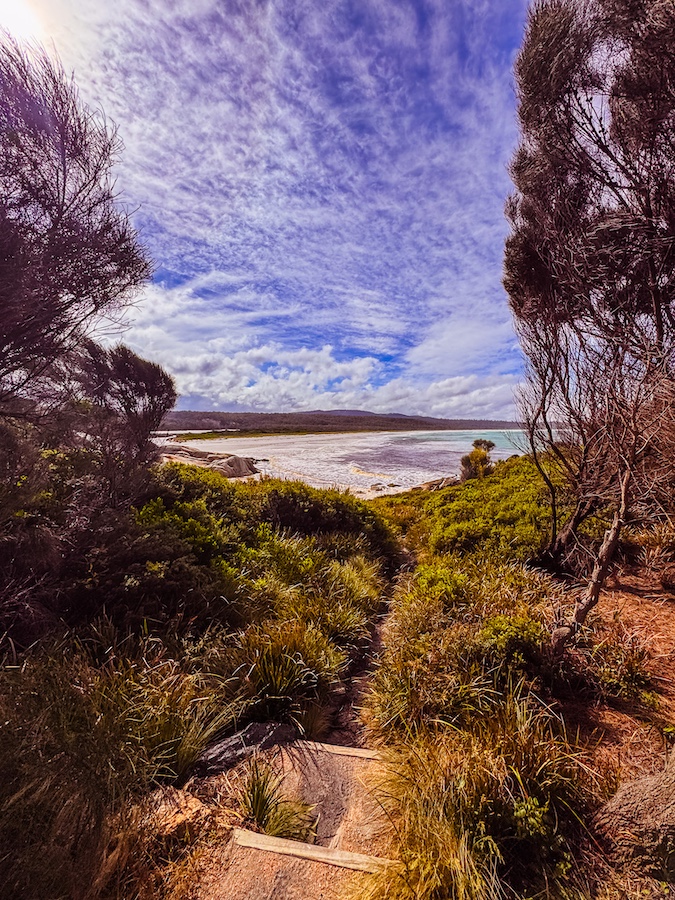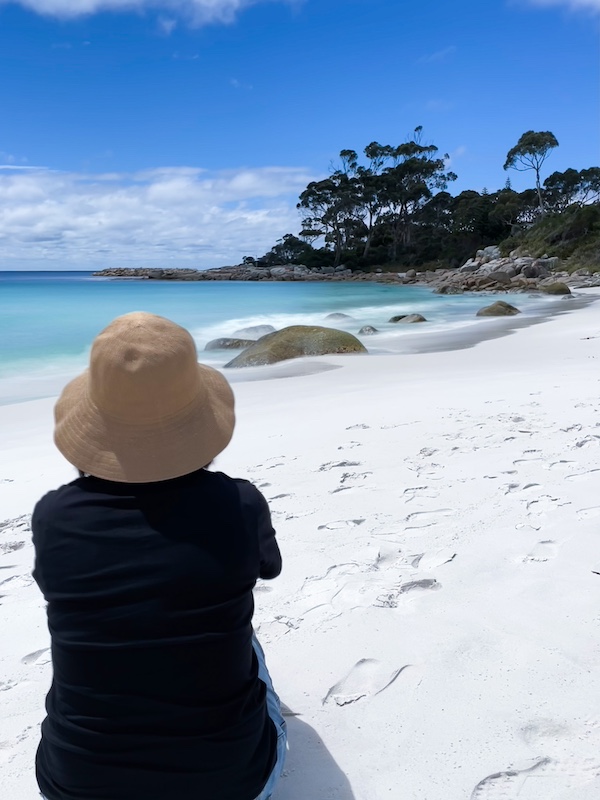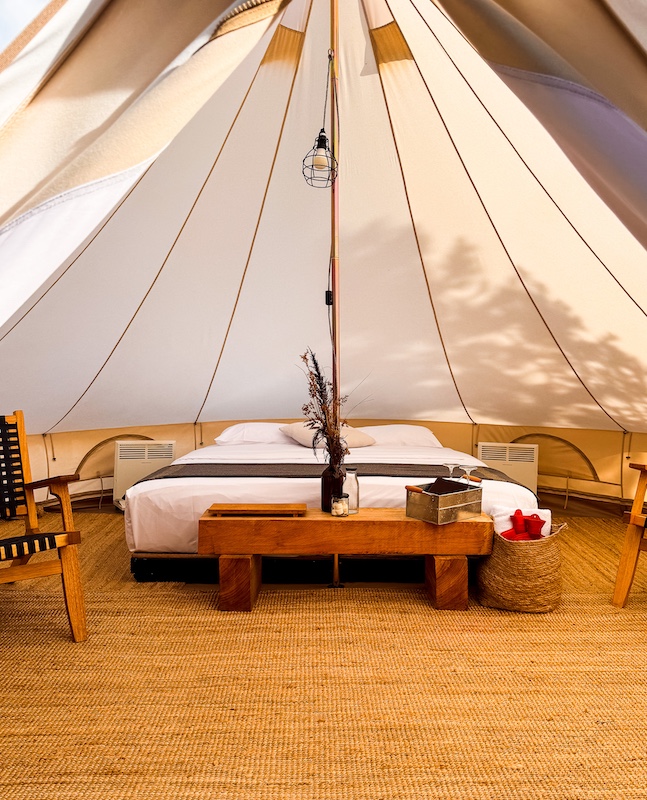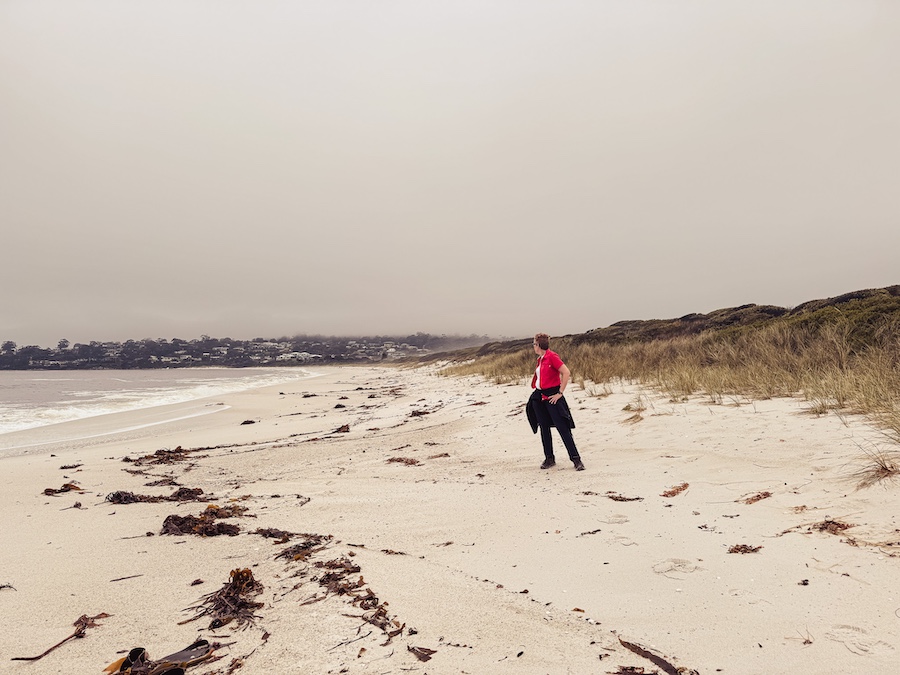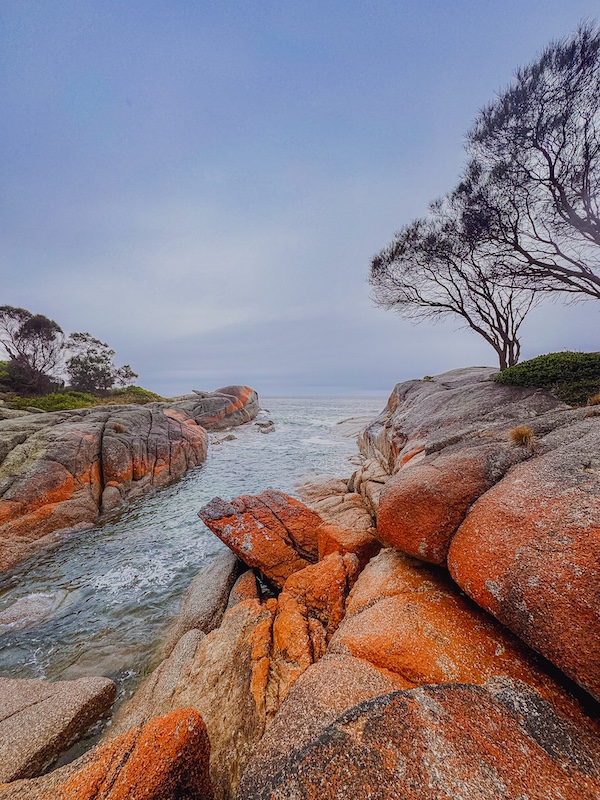Bay of Fires Tasmania
Boulders, Beaches & the Big Blue BeyondBeautiful Bay of Fires in Tasmania: The Essential 2025 Guide 🏖️
There’s a moment when you first see the Bay of Fires in Tasmania that doesn’t quite feel real. The sky opens up, the sand turns blinding white, and the ocean looks like it’s been filtered through a Instagram feed — only there’s no filter, and no crowds either.
Just you, a strip of wild coastline, and the whistling wind.
The Bay of Fires in Tasmania stretches north from Binalong Bay up to Eddystone Point, with some of the whitest beaches and clearest water you’ll find anywhere. But it’s the rocks that steal the show — giant granite boulders, streaked and splotched with vivid orange lichen, as if someone dragged a painter’s brush right across the shoreline.
It’s raw, rugged, and surprisingly empty most of the year.
We drove in from Launceston, winding through sleepy farming towns until the landscape cracked open and dropped us at the edge of the sea. Mesmerised.
We stayed a couple of nights glamping at the famous Bay of Fires Bush Retreat tucked just behind the dunes, waking to the soft shuffle of wallabies outside the tent. Two days spent on walks and boulder-hopping along The Gardens and Sloop Reef, getting caught in wild bursts of sea mist, and hunting for the perfect oyster nearby. Zoe almost stepped on a tiger snake one morning at Cozy Corner — a sharp reminder that this part of Tasmania is still properly wild.
This guide pulls together everything you need to plan your own Bay of Fires trip — the best beaches, the walks worth doing, where to stay, when to visit, and practical tips that only come from actually being there (a few times now!).
If you’re looking for a place where the world feels big again, where the beaches are wide open and the air tastes like salt and eucalyptus, Bay of Fires Tasmania is that place. And if you’re anything like us, you’ll already be planning your next visit before you even leave the place.
Where is Bay of Fires in Tasmania?
The Bay of Fires in Tasmania runs along the island’s far northeast coast, roughly between Binalong Bay and Eddystone Point. It’s not a single beach, but a whole chain of them — broken up by rocky headlands, secret coves, and stretches of bushland that feel about as wild as Tasmania gets.
The Bay of Fires sits just north of the small town of St Helens, about halfway up Tasmania’s east coast if you’re tracing it by map. From St Helens, it’s an easy ten-minute drive to the southern entry point at Binalong Bay. Beyond that, the road gets narrower and the crowds thin out even more, as you push further into The Gardens and up toward Mount William National Park.
Despite how remote it feels once you’re there, Bay of Fires Tasmania is surprisingly accessible — especially if you’re already planning an East Coast road trip. It’s the kind of place you could easily miss if you didn’t know it was tucked just beyond the bends and forests. But trust me: it’s worth the detour.
Bay of Fires (Tasmania) Map
How to get to Bay of Fires
Most people get to Bay of Fires Tasmania by car — and that’s part of the magic. Driving lets you take it slow, pull over at lookouts, and catch those first glimpses of the ocean when it flashes between the trees.
Launceston to Bay of Fires
The most popular and straightforward route is driving from Launceston.
It’s about 2 hours and 20 minutes by car, covering around 175 kilometres across a changing landscape of farmland, forests, and winding coast.
We followed the route I share in my Launceston to St Helens Road Trip 2025 guide, and it’s easily one of the most scenic drives on the island if you know where to stop. Expect rolling paddocks full of cows, misty mountain bends, and the occasional bakery good enough to make you pull over.
Once you reach St Helens — the unofficial gateway to the Bay of Fires — it’s a straight shot along Binalong Bay Road to the beach.
If you’re hiring a car, just make sure it’s ready for a bit of gravel if you plan to head beyond Binalong Bay to places like The Gardens or Swimcart Beach.
Hobart to Bay of Fires
Coming from Hobart? You’re looking at around 3.5 to 4 hours of drive time, depending on how many bakery stops you make along the way.
It’s a beautiful journey either through the Midlands and across to the coast at St Marys, or along the longer but prettier Great Eastern Drive if you want to see Orford, Swansea, and Freycinet National Park on the way.
If you’ve got time, I recommend making it part of a bigger East Coast loop — you can start in Hobart, drift up the East Coast via Freycinet and Bicheno, hit Bay of Fires, and finish in Launceston. It’s a classic Tasmanian road trip for good reason.
Devonport to Bay of Fires
If you’re bringing your car over on the Spirit of Tasmania ferry from the mainland, you’ll dock at Devonport.
From there, it’s around a 3-hour drive across to St Helens. You’ll pass through sleepy inland towns and rolling farmland — not as coastal as the East Coast drive, but still a relaxed and easy trip.
Getting to Bay of Fires Without a Car
It’s possible — but it’s a bit trickier.
There’s no bus from Launceston to Bay of Fires but there is a bus from Launceston to St Helens by Calow Coaches. Services are limited to two daily monday to friday and one on saturday. The bus doesn’t run out to the beaches themselves. If you’re not driving, you’ll either need to base yourself in St Helens and book a local taxi or arrange a tour from Launceston.
There are also guided tours departing from Launceston if you prefer someone else to handle the driving (and the storytelling).
But honestly? Bay of Fires rewards the slow travellers. If you can, get a set of wheels, take the coast road, and give yourself a few days to soak it all in.
Binalong Bay, the Gardens and more
Bay of Fires Beaches
You could spend a week exploring the Bay of Fires Tasmania coastline and still find beaches where yours are the only footprints in the sand. It’s not one long stretch, but a series of beaches and coves stitched together by low dunes, granite headlands, and pockets of wild bush. Each spot has its own character — from easy-access swims to rocky boulder mazes that beg you to explore.
Here’s where we spent most of our time — and a few places we’ll be heading back to next trip. 👇🏽
Binalong Bay Beach
If you’re heading to Bay of Fires for the first time, Binalong Bay Beach is probably where you’ll land first.
It’s the easiest beach to reach (about 10 minutes from St Helens), with a big sweep of clean, powdery white sand and that ridiculously clear, turquoise water.
We parked near the main access and walked straight out onto the sand — the kind that squeaks under your shoes because it’s so fine. It’s the Bay of Fires’ busiest beach. The tour buses all stop here. But even in summer, you can find whole sections to yourself just by walking 10 minutes north up the beach.
The water here is calm enough for a dip if you can brave the chill — Tasmania’s seas rarely get properly “warm,” but on a sunny day in March, it’s pure bliss once you’re in.
There’s a boat ramp and a cafe (the Hub) nearby, but otherwise, Binalong Bay keeps it simple. Sand, sea, sun, shacks, and that feeling that maybe — just maybe — you’ve stumbled across a secret the rest of the world hasn’t figured out yet.
Swimcart Beach & Cosy Corner
If you’re keen to camp right by the beach — or just want a spot that feels properly off-grid — Swimcart Beach and Cosy Corner are hard to beat. Both are located a little north of Binalong Bay along the main track into the Bay of Fires Conservation Area.
Swimcart Beach is classic Bay of Fires: long, white, and often near-empty. With the occasional beach fisher or lone wanderer. Cosy Corner has slightly more shelter thanks to rocky points at either end and is a favourite for beachfront camping.
You have to get in early for a camp spot in peak season and the bad news is they’re not bookable. But the good news is, there’s plenty of camp sites right through the Bay of Fires Conservation area just a stones throw from the beaches.
Even if you’re not camping, it’s worth the detour to sit on a log, watch the waves roll in, and understand why so many travellers end up staying longer than planned. We drove in just to have a look — and felt like never leaving
Sloop Reef
Don’t feel intimidated by all the dirt roads off the main road along the coast – just turn in and explore them. This is where you’ll find secret spots like Sloop Reef. Sloop Reef is tucked away down a bumpy sandy track ( 20km/h or you might lose your suspension!), and it’s a gem if you like your beaches a bit wilder.
We followed that bumpy track down through the scrub and found ourselves standing at a rocky outcrop framed by scattered orange boulders with beaches stretching north to the horizon.
The ocean was a little rough the day we visited, with mist blowing off the breakers, and not another soul in sight. Perfect for a head-clearing rock scramble or deserted beach combing. It’s the kind of beach where you don’t need a plan — just pick a direction and start walking.
There’s minimal signage and no facilities here, which suits the place perfectly. Bring water, leave no trace, and soak it up.
The Gardens
Keep driving north along the coast road past Binalong Bay, Swimcart Beach and Sloop Reef and you’ll hit The Gardens — one of the most dramatic parts of Bay of Fires Tasmania.
This is where the fiery orange boulders really start to take over the landscape, tumbling down into hidden coves and framing every view with jagged bursts of colour.
We spent a morning here scrambling over boulders, peering into rock pools, and just soaking up the wildness of it all. It’s easy to find your own little patch of rock to sit on and watch the ocean hammer the coastline.
You come here for the firey red boulders and the views rather than the beach itself. The walking’s not hard, but it’s uneven — decent shoes help if you want to clamber around properly (and avoid a slip).
This is a busy little stop with a small carpark so it’s not as easy to get in and out.
The main lookout gives you a panoramic view up and down the coast. On a clear day, it feels like the world just keeps going — nothing but sea and sky and rock.
Other Hidden Bay of Fires Beaches
The magic of Bay of Fires Tasmania is that you don’t really need a guidebook to find the best spots.
Every bend in the coast hides another beach or rocky inlet worth exploring.
Places like Taylors Beach, Jeanneret Beach, and Grants Point are all within a short drive — or a longer wander if you’re up for a day of beach-hopping.
We did the walk to Jeanneret Beach following a trail from Binalong Bay— Zoe nearly stepped on a tiger snake sunning itself by the path (watch where you walk!). It’s those little moments — the unexpected discoveries — that make Bay of Fires feel like a real adventure.
Swimming, paddling, glamping, rock hopping & more
Things to do in Bay of fires Tasmania
If you’re heading to the Bay of Fires Tasmania, be ready to slow down. This isn’t the place for jam-packed sightseeing itineraries. It’s the kind of coast where a perfect day might mean swimming in a beach you can’t name, climbing rocks just to see what’s on the other side, or watching the clouds roll in over an empty stretch of sand.
Here’s what we spent most of our time doing — and the Bay of Fires activities you shouldn’t miss.
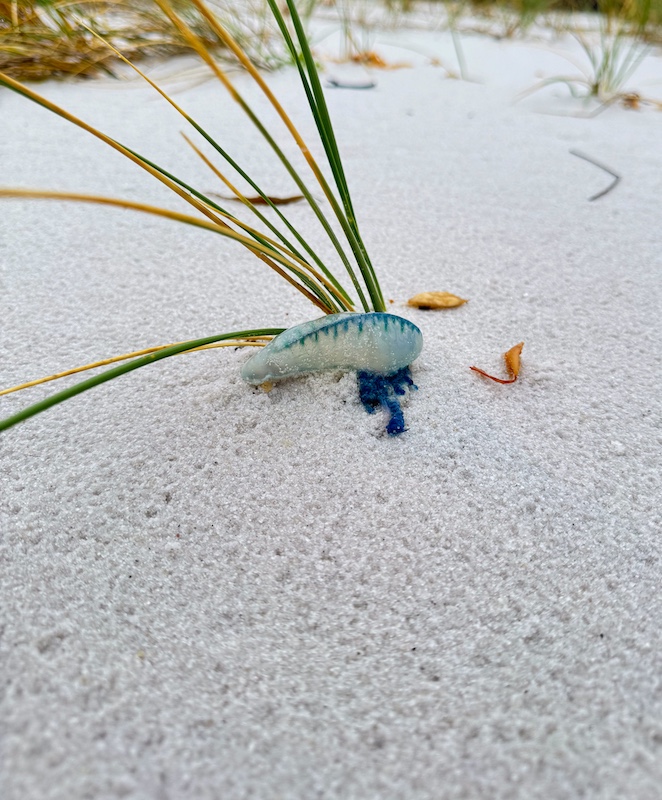
Beachcombing & Long Wanders
One of the best things to do at Bay of Fires Tasmania is also the simplest: just start walking.
Pick a direction — north or south — and follow the curve of the beach until the world shrinks down to sand, sky, and the sound of your own feet. There are shells to find, driftwood bleached by the sun, and curious rock pools hiding small crabs and tiny fish.
Every corner reveals another beach, another stretch of sand with no footprints but your own.
If you want a real reset, leave your phone in the car and just wander until you lose track of time.

Glamping under the stars
Glamping Tasmania’s Bay of Fires isn’t just where you sleep — it’s part of the whole experience.
We stayed at Bay of Fires Bush Retreat just back from the beach, where the tents come with real beds, crackling firepits, and the kind of quiet you can hear in your bones.
At night, the stars roll out overhead and the fairy lights flicker through the bush. In the mornings, it’s birdsong and mist and the first light spilling over the trees.
There’s something about sleeping under canvas that makes the whole place feel closer — the ocean, the bush, the big Tassie sky.
If you want a few creature comforts without losing the feeling of being properly outdoors, glamping is the way to go.
You can read more about our stay — and find other spots across the island — in my Glamping in Tasmania guide.
Bay of Fires Bush Retreat
Kayaking and Paddle Adventures
When the weather’s calm, kayaking along the Bay of Fires coastline is next-level.
Some of the beaches — especially around Binalong Bay — are sheltered enough for a paddle without needing surf skills.
Poppa’s Boat Hire in St Helens offers kayak and stand-up paddle board rentals, making it easy to explore at your own pace.
They’ll even sort you out with fishing gear if you want to drop a line from the kayak.
(They also hire out small boats if you’re feeling more adventurous — check their rental options here.)
It’s a different way to see the coastline — slower, quieter, and a good chance of spotting dolphins or seabirds up close.
Fishing from the Beach
If you’re caravaning around Tassie — or just like the idea of catching your own dinner — bring a fishing rod. Beach fishing is big around the Bay of Fires, especially near Swimcart Beach, Cosy Corner, and the reefs near Sloop Reef.
It’s the classic Tassie setup: you back the van up to the dunes, cast into the surf, and hope for flathead, Australian salmon, or bream.
Early mornings and late afternoons are the best times, when the tide’s moving and the light’s low.
If you didn’t pack gear, Poppa’s Boat Hire in St Helens rents bait, tackle, and fishing rods — so you can set yourself up without needing to cart everything across the island. (They’ll even give you some local tips on where it’s biting.)
Fishing here isn’t about trophy catches — it’s about standing barefoot in the sand, feeling the ocean pull, and maybe cooking up something fresh for dinner under the stars.

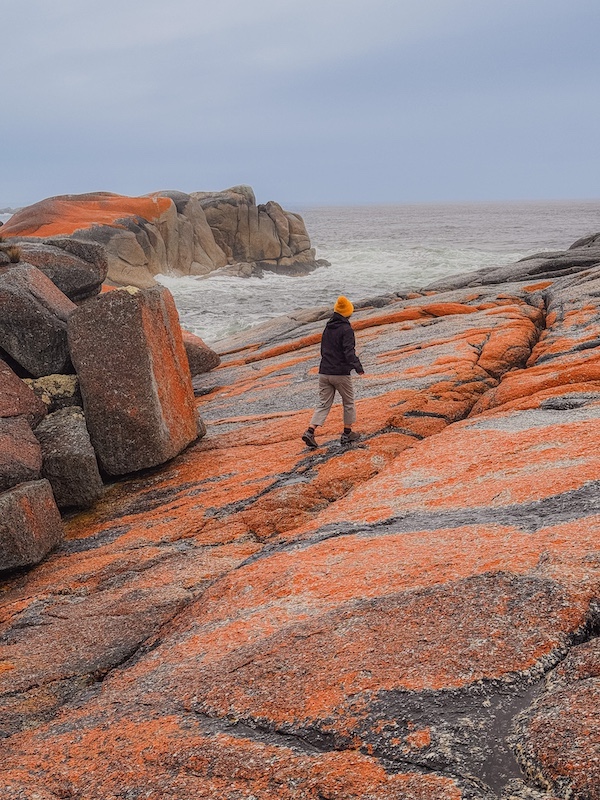
Photography & Rock Hopping
The Bay of Fires is a dream if you like chasing light, colour, and rugged scenery. We spent hours boulder-hopping around The Gardens and Sloop Reef, trying to find the best angle of the fiery orange rocks against the aqua water.
Sunrise and sunset are magic here.
The low light fires up the lichen even more, and if you’re lucky, you’ll catch mist rolling in over the beaches.
If you want to take your photography up a notch, there’s even a 3-Day Bay of Fires Photography Workshop from Hobart that runs small group tours out to the best spots — sunrise shoots, golden hour coaching, and local guides who know where to find those secret perspectives. It’s a unique option if you’re serious about getting more out of your camera (and a good excuse to spend a few extra days up here).
Bring sturdy shoes, take it slow on the wet rocks, and don’t forget to just stop and soak it in — the best photos aren’t always the obvious ones.
Planning a road trip to Bay of Fires? 👇🏽
Bay of Fires Tasmania
Walking Tracks
If you’re the kind of traveller who likes exploring on foot, the Bay of Fires in Tasmania has a few hidden gems tucked between the beaches.
You don’t need heavy boots or a hardcore map to find them — just a sense of adventure and a good pair of shoes.
Here are the Bay of Fires short walks we walked, what we learned (sometimes the hard way), and a few options if you want to stretch it out into a proper trek.
Binalong Bay Coastal Walk (to Jeanneret Beach)
If you’re looking for an easy, flexible walk straight from Binalong Bay, this is it.
We started right at Binalong Bay Beach — one of those mornings where the sky was heavy with salt mist — and headed north along the sand. When the tide’s low, you can simply walk the beach the whole way, hopping around the occasional rocky points.
If the tide’s high, there’s a grassy coastal track that winds behind the dunes through scrubby bush and open patches of coastal grass.
It’s an easy, mostly flat walk — but not without its wild moments.
We spotted dozens of tiny baby blue jellyfish washed up along the tideline like little blobs of glass.
Further along, we scrambled over a massive wall of orange boulders linking Cosy Corner to Jeanneret Beach — easily the best fun of the whole walk if you’re part mountain goat.
Jeanneret Beach itself is a long sweep of sand that’s popular with beach fishers.
Just a heads-up: keep your eyes peeled if you take the grassland track.Zoe almost stepped on a curled-up tiger snake sunning itself by the path — deadly, and a good reminder that you’re walking through real Tasmanian bush.
We’ve also spotted copperhead snakes along the scrubby cliffs above the beach. Both snakes are venomous but generally shy — they’ll leave you alone if you leave them alone. Wear long pants, closed shoes, and make a bit of noise as you walk. They’re mostly above in the summer months–December to March.
If in doubt — or if the weather’s good — stick to the beach route for this walk. It starts on Binalong Bay Beach, heading north. It’s safer in summer, and you’re less likely to get surprised.
Distance depends on how far you want to go, but a relaxed walk from Binalong Bay to Jeanneret Beach and back takes about 1.5 to 2 hours, including rock-hopping and photo stops.
Short Walks at The Gardens
Even if you’re not up for a long coastal walk, The Gardens is worth pulling over for. This spot is one of the most photographed areas along the Bay of Fires Tasmania — and it’s easy to see why.
From the main carpark, there’s a series of short walking tracks weaving through the landscape.
You don’t need a map — just follow your nose. Each little path takes you to a different lookout, with slightly different angles of the coast, the rocks, and the wild open sea beyond.
In total, you’re looking at about 1 kilometre of wandering if you explore them all, but it’s not about distance here — it’s about soaking up the views. The biggest, brightest boulders are right here too, stacked and scattered like a giant playground. If you’re into photography, it’s a dream: fiery orange lichen, pale sands, turquoise water, and sky that just seems to go on forever.
You can also scramble down onto the beach if you want a closer look at Koala Rock — a quirky boulder shaped (somewhat vaguely) like a koala that’s become a local landmark.
The beach at The Gardens is stunning on a calm day, but even when the surf’s up and the wind’s whipping off the water, it’s still wildly beautiful.
Allow at least 45 minutes to an hour here if you want to properly poke around, scramble on the rocks, and see it from every angle. We ended up staying longer than planned — it’s just that kind of place.
The Gardens to Break Yoke Creek
If you want a longer walk with a bit more edge to it, the coastal track from The Gardens to Break Yoke Creek is worth the effort.
It’s primarily a beach and boulder scramble, starting at The Gardens carpark and heading north along the coast.
When the tide’s low, you’ll have long stretches of white beach to wander, broken up by rocky headlands where you’ll need to climb and weave your way over the giant orange boulders.
At high tide, there’s not much sand left — and the rocks can be slippery — so it’s best tackled around low tide when you’ve got room to move.
The scenery on this walk is some of the best on the whole East Coast:
- Wild surf crashing against the rocks,
- Blazing lichen-covered boulders glowing against turquoise water,
- And long empty beaches that feel like they belong to another world.
It’s not a technical hike, but it’s not ideal for young kids (under 10) — some of the boulders you’ll need to scramble over are high, uneven, and exposed to the elements.
Decent shoes are a must, and don’t be surprised if you’re using your hands just as much as your feet on some of the rocky sections.
Allow a few hours return if you’re planning to explore all the way out and back.
There’s no shade and no facilities along the way — so bring water, sun protection, and keep an eye on the tide times before you set out.
If you’re after a coastal adventure that feels a little off the edge of the map, this one delivers.
Go deeper into bay of fires
Multi Day WalkinG
Tour options
If you want to properly immerse yourself in the Bay of Fires — not just for an afternoon, but for days — there are two standout Bay of Fires walking tour options.
4-Day Bay of Fires Walking Tour from Launceston
If you’re looking for something a little less expensive but fun, fully organised, and that walks the same route as the tours that chrage big bucks, this 4-Day Bay of Fires Walking Tour from Launceston is a great pick.
This tour runs from October to April, when conditions are best, and it’s perfect for:
- Solo travellers looking for a group to hike with
- Couples who want to experience the Bay of Fires without worrying about planning every detail
- Anyone who’s happy to walk but doesn’t want to carry a heavy pack – it’s a day pack only guided tour.
The itinerary covers some of the best beaches and walking tracks along the Bay of Fires, and you’ll stay in comfortable accommodation each night. Not the Bay of Fires Lodge, but you’ll pay far less for this tour.
Transport, meals, guides — it’s all included.
Spots are limited each season because it’s small group only and runs 5 months of the year — so if you’re even thinking about it, book early to lock in your spot. You’ll be surprised at the value you get for the price of this tour.
Check availability and prices here
Bay of Fires Lodge Walk
The Bay of Fires Lodge Walk – also called the Signature Bay of Fires Walk – is Tasmania’s premier luxury walking experience along this coastline and it’s offered by ac couple of different companies. Tasmania Walking Company and Tasmanian Expeditions.
It’s a multi-day trek (3 or 5 days), starting with beach walking and rocky coast exploration and some tracks through coastal heathlands.
Night one is spent in an already set up beach camp. You also get to stay 2 nights in the exclusive Bay of Fires lodge, tucked away in the bush north of Ansons Bay, have delicious prepared for you long table meals and there’s even a spa option.
There’s nothing hardcore about this trip: you carry a daypack only. This is the lux version of all Bay of Fires multi day walks. It runs from October to May and costs almost twice the first tour 👆🏼 but the memories and experience are both unforgettable.
If you’re someone who loves a good hike but doesn’t want to rough it, this is the premium way to experience the full stretch of the Bay of Fires coastline.
Bay of Fires Self Guided Walks
By popular demand, here’s a multi day Bay of Fires Hike you can do for just $60. Beautiful Bay of Fires on a budget. Whoohoo!

Accommodation at Bay of Fires Tasmania
When it comes to staying near Bay of Fires Tasmania, you’ve got three main options — and each one suits a different kind of trip.
Here’s how they stack up.
St Helens & Georges Bay
If you’re looking for cheaper accommodation near Bay of Fires — or you just like having a few more cafes and shops within stumbling distance — St Helens is a solid base. It’s about 11km (15 minutes drive) from St Helens to Binalong Bay, and a bit further to the main Bay of Fires beaches.
But the trade-off is real amenities:
• Supermarkets (IGA and a big new Mitre 10 for gear)
• Cafes, restaurants, and bakeries
• Pharmacy, petrol, bottle shops, and basic supplies
Accommodation here runs from budget motels to holiday parks, cabins, and a growing number of Airbnb rentals. You’ll pay a lot less than beachfront stays, and for road trippers or longer stays, it’s a smart choice.
St Helens is also handy if you’re planning side trips — like hitting the St Helens Mountain Bike Trails or taking a drive up to Eddystone Point. For more options around St Helens, I’ve put together a full St Helens Accommodation guide with the best places to stay.
Binalong Bay Accommodation
Binalong Bay offers the next best thing to staying within the Bay of Fires Conservation area:
- A short walk or drive Bay of Fires beaches
- Stunning views over Binalong Bay Beach itself
- And a slightly friendlier price tag
Accommodation here is mostly holiday homes and classic Tasmanian beach shacks — think timber decks, outdoor showers, and ocean breezes. It’s a popular spot for families and couples who want the beach vibe without total isolation.
There’s a tiny cafe and restaurant — The Hub — for coffee, meals, and lazy brunches. But that’s it. No supermarket, no petrol station. For everything else, you’ll need to head back into St Helens.
You’ll find the full list of Binalong Bay options in my Bay of Fires Accommodation guide.
Bay of Fires Conservation Area
If you want to wake up with the sand between your toes and the ocean in your ears, staying inside the Bay of Fires Conservation Area is the way to go.
It’s the most expensive option — but you’re paying for privacy, proximity, and those hard-to-beat views.
Most of the accommodation here is made up of holiday homes, plus a few old-school beach shacks that have somehow survived the wave of modern rebuilds.
There’s also the Bay of Fires Bush Retreat, where we stayed — offering glamping tents, campgrounds, and cabins just a few minutes inland from the beach.
If you want a slice of wilderness without giving up a comfortable bed, it’s a perfect balance.
There are no shops or services inside the conservation area, so you’ll need to stock up in St Helens before you arrive.
But once you’re here, it’s all about slowing down — wandering empty beaches, cooking dinner on the deck, watching the light change over the boulders.
(If you want a full list of places to stay inside Bay of Fires, head to my Bay of Fires Accommodation guide.)
Tours to Bay of Fires from Launceston & Transport Options
If you’re planning a trip to Bay of Fires Tasmania, the big question is how you’re getting there — and how much of it you want to experience on your own. You’ve got two main choices: book a tour and let someone else do the driving, or go self-drive and build your own adventure. Here’s what you need to know.
Guided Day Tours from Launceston to Bay of Fires
If you don’t want to hire a car, or you just prefer someone else to handle the logistics, there are a few solid tour options that leave from Launceston.
Grayline Tours offer full-day tours to Bay of Fires from Launceston. They usually cover: a drive to Binalong Bay, a few scenic stops along the coast (like The Gardens), a visit to St Helens for lunch, and sometimes a bonus stop at Pyengana Dairy or St Columba Falls inland. They’re a good option if you’re short on time — you’ll see the highlights, hear a few local stories, and be back in Launceston by dinner.
If you have a small group and want to set your own itinerary but with a local guide to give you peace of mind on the winding roads and all of the local insights,
Just be aware you’ll only scratch the surface with a day tour. Bay of Fires deserves more than a few hours if you can spare them.
If you really want to dive deeper into Bay of Fires — not just for a photo stop, but to actually experience it — there’s one tour I recommend. The 4-Day Bay of Fires Walking Tour from Launceston is built for travellers who want to slow down and actually feel the place. Over four days, you’ll walk along empty beaches and rocky headlands, stay in eco-lodge accommodation right near the coast, eat fresh, local food, and travel with a small group so you’re not lost in a big crowd. It’s a guided trip — but it still feels wild and free. The tour only runs October to April, and spots fill fast because they keep group sizes small.
This tour’s a smart choice for solo travellers, couples, or anyone who doesn’t want to worry about organising accommodation, gear, and logistics themselves. If you’re even half-thinking about doing a walking tour, lock it in early — this one gets rave reviews for good reason.
Multiday Tasmania Tours incl. Bay of Fires

Wild Tasmania tour
5 ⭐️ (90 reviews) | 4 days
This popular tour starts in Hobart and ventures to the wild West Coast, Cradle Mountain and down the East Coast with a stop of course in Bay of Fires. It’s a super highlights tour on steroids, great value and an excellent way to see Bay of Fires on a short itinerary.
Leaves from Hobart. Book early this one sells out fast.

Tasmania Adventure Tour
5 ⭐️ (60 reviews) | 6 Days
Builds on the 4 day tour 👈🏼 with extra time in Strahan, Richmond, and visits to Mt Wellington and Bonorong Wildlife Sanctuary. AND you overnight in St Helens with visits to Bay of Fires over 2 days (= more time at the Bay).
Leaves from Hobart. Departs Saturdays between October & April.

Ultimate Tasmania tour
5 ⭐️ (20 reviews) | 10 days
10 days is a perfect to see Tasmania and this tour makes the most of every day. With a full lap of Tasmania, including a 3 hour stop in at St Helens and Bay of Fires, you get less Bay but more Bruny Island & Port Arthur. Operates Sept to April.
Leaves from Hobart. Likely to sell out so book early.’
Public Transport and Coaches
It’s possible — but not easy — to reach Bay of Fires without a car. There’s a bus service from Launceston to St Helens (route 740) run by Kinetic Tasmania. The service usually runs once or twice daily and takes about 2.5 hours.
From St Helens, you’ll need to arrange a taxi or private transfer to Binalong Bay or the Bay of Fires beaches — there’s no public transport covering the last stretch to the coast.
It’s doable for flexible travellers or backpackers, but if you want to hop between beaches, do walks, or camp, a car will make your life a lot easier.
Which Option Should You Choose?
If you’ve got time and like your freedom, self-drive. Stay a few nights and explore at your own pace. This is absolutely our favourite option for Bay of Fires because of all the exploring there is to do. But not everyone has the luxury of time…
If you want a taste but are short on time, a day tour from Launceston will tick the main boxes. You’ll spend a couple of hours seeing the best beaches on offer.
If you want a deep, memorable experience, book the 4-Day Bay of Fires Walking Tour and give yourself time to properly walk the coastline. However you get here, the Bay of Fires delivers. It’s the kind of place that rewards those who slow down, wander a little further, and stay a little longer.
If you want to see Bay of Fires AND Tasmania’s other highlights, take a multi-day tour from Hobart instead.
What to know before you go
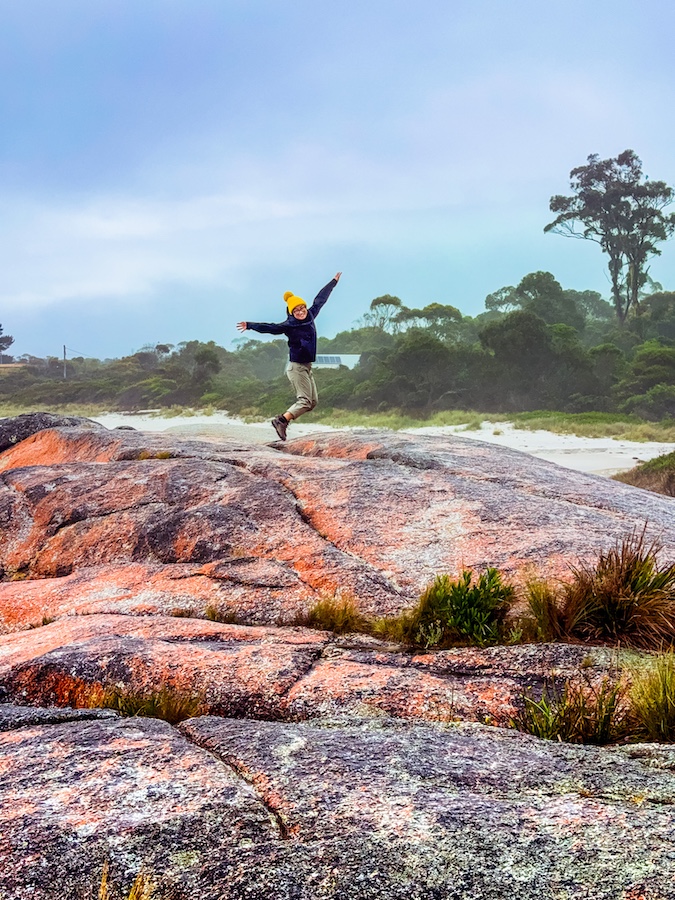
TLDR: When to go – the short version:
- For swimming: aim for late January to early March.
- For walking: March to May, and again from late October to early December.
- For peace and quiet: winter and early spring.
- For photography: year-round, but autumn and winter light can be especially magical.
Whenever you visit, Bay of Fires delivers. Just pack for a bit of everything — sun, wind, and the odd rogue shower — and you’ll be ready for it.
Best Time to Visit Bay of Fires Tasmania
Tasmania’s northeast coast has some of the best weather on the island — but even here, timing your trip to Bay of Fires Tasmania makes a difference.
The Bay of Fires has a mild, coastal climate year-round, with warmer, drier conditions than much of Tasmania’s west and south. That’s part of why it feels so untouched — the beaches stay beautiful without being battered by heavy winter rains.
Here’s what you can expect through the seasons.
Summer (December to February):
Summer is peak season for a reason. Days are long, dry, and warm, with temperatures often hitting between 20°C and 25°C. The ocean is still on the chilly side — Tasmanian waters don’t exactly heat up — but late January and February offer the best chance for a relatively “warm” swim (by Tassie standards). Expect clear skies, dry trails, and plenty of sunbaking wallabies. It’s also when Bay of Fires is at its busiest, especially during school holidays, so book accommodation early.
Autumn (March to May):
Autumn might just be the best-kept secret. The days stay warm into March and even April, with lower crowds and gorgeous light for photography. You’ll still get beach-worthy weather in early autumn, but without the summer rush. Later in the season, nights get cooler, and there’s a slight uptick in rainfall — good news if you like moody skies and empty beaches.
Winter (June to August):
Winter is the quietest time at Bay of Fires Tasmania. Expect daytime temperatures around 10°C to 14°C, crisp offshore winds, and the beaches almost entirely to yourself. Swimming’s only for the brave, but it’s a brilliant time for walking, beachcombing, and photography — especially if you like misty mornings and dramatic light. Just bring a proper jacket and be prepared for short, sharp showers.
Spring (September to November):
Spring can be a mixed bag. September and October often bring strong winds and occasional cold snaps, but by November, the coast wakes up again. Wildflowers start blooming behind the dunes, the days get longer, and it’s an excellent time for walks and wildlife spotting. Crowds stay low until late November, making it a smart time to visit if you want the place almost to yourself.
8 Final Tips for Visiting Bay of Fires
Planning ahead makes a big difference when you’re heading to Bay of Fires. It’s a wild part of Tasmania — and that’s exactly why it’s so good. Here are a few practical tips to help your trip run smoothly.
1. Book accommodation early in peak season
If you’re travelling between December and February, or over Easter, book your stay as early as you can. Good beach houses and glamping spots near Bay of Fires sell out months ahead, especially anything within walking distance of the beach.
2. Fill up your tank in St Helens
There are no petrol stations in Binalong Bay or anywhere inside the Bay of Fires Conservation Area. Fill your tank in St Helens before you head out along the coast, especially if you’re planning to explore further north toward Eddystone Point or Mount William National Park.
3. Stock up on supplies in town
There are no supermarkets, general stores, or ATMs at Bay of Fires. St Helens has two IGAs, a bottle shop, pharmacies, and basic camping and fishing supplies. Grab what you need before heading out — you won’t want to waste beach time driving back for essentials.
4. Expect patchy mobile reception
You’ll get decent mobile reception around Binalong Bay and parts of southern Bay of Fires, but it drops out quickly as you head north past Swimcart Beach and The Gardens. Download maps before you go, and don’t expect perfect coverage if you’re wandering off the beaten track.
5. Check tide times if you’re planning beach walks
Some of the best walks at Bay of Fires — like Binalong Bay to Jeanneret Beach, and The Gardens to Break Yoke Creek — are much easier (and safer) at low tide. Boulder scrambling can get slippery at high tide, and beaches can disappear completely under big swells.
6. Bring layers for every season
Tasmania’s east coast can swing from hot and sunny to misty and cold, even in summer. Pack for all conditions: light clothes for sunny days, a decent windproof jacket for evenings, and good shoes for beach walking and rock scrambling.
7. Stay snake-smart
Tiger snakes and copperheads are native to the Bay of Fires region. They’re venomous but shy — watch where you step, especially in long grass and on warm tracks, and wear closed shoes. Most encounters are uneventful if you leave them alone.
8. Give yourself more time than you think you need
It’s easy to underestimate Bay of Fires. What looks like a quick stop on the map turns into a full day of wandering, swimming, and exploring. If you can, stay at least two nights. You’ll experience the beaches at sunrise, sunset, and in between — and that’s when the real magic happens.
FAQs about Bay of Fires
Where is Bay of Fires in Tasmania?
Bay of Fires is located on the northeast coast of Tasmania, stretching from Binalong Bay in the south up to Eddystone Point in the north. It runs along the edge of Mount William National Park, with St Helens being the closest town and main service centre for the area.
How far is Bay of Fires from Hobart?
Bay of Fires is about 265 kilometres from Hobart. Driving takes around 3.5 to 4 hours, depending on your route and how many scenic stops you make. The quickest way is through the Midlands and over the hills near St Marys, but if you have time, the East Coast drive via Orford and Freycinet is far more scenic.
How far is Bay of Fires from Launceston?
Bay of Fires is about 175 kilometres from Launceston, with a drive time of around 2 hours and 20 minutes. It’s a straightforward drive, mainly via the Tasman Highway. If you’re coming this way, I’ve mapped out the best stops and tips in my Launceston to St Helens Road Trip guide.
How far is Bay of Fires from Cradle Mountain?
Bay of Fires is roughly 260 kilometres from Cradle Mountain by road. It usually takes about 4 hours to drive, cutting across the middle of Tasmania through Scottsdale and either Deloraine or Sheffield.. The drive is not easy –road can be winding in places. So it’s worth planning a few stops to break it up.
What to bring with you overnight
Definitely bring a head lamp and a camp lantern. There’s no candles allowed in the rooms.
Bring your bedding – sleeping bags, pillows – the bunks are simple vinyl covered mattresses.
There is a weak wifi signal so if you want to be online bring a power bank.

